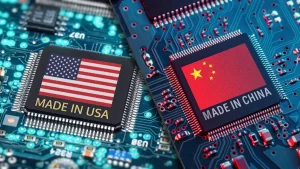In the ever-evolving landscape of global technology, the competition between the United States and China has become increasingly pronounced. At the forefront of this battle is the race for supremacy in artificial intelligence (AI), a field heavily reliant on cutting-edge semiconductor technology. As tensions escalate between the two superpowers, the US is contemplating imposing further
In the ever-evolving landscape of global technology, the competition between the United States and China has become increasingly pronounced. At the forefront of this battle is the race for supremacy in artificial intelligence (AI), a field heavily reliant on cutting-edge semiconductor technology. As tensions escalate between the two superpowers, the US is contemplating imposing further restrictions on China’s access to crucial semiconductor chips, a move that could have significant ramifications for both countries and the global tech industry.
The Importance of Semiconductor Chips in AI

This image is taken from google.com
Semiconductor chips serve as the backbone of AI technology, powering everything from data processing to machine learning algorithms. With the exponential growth of AI applications across various sectors, the demand for these chips has skyrocketed. Companies and governments alike recognize the strategic significance of controlling the production and supply of semiconductor chips, as they are essential for maintaining competitiveness in the AI race.
Current Landscape
The US currently dominates the global semiconductor industry, with companies like Intel, AMD, and Nvidia leading the charge in chip manufacturing and innovation. However, China has been aggressively investing in its semiconductor sector in an effort to reduce its dependence on foreign technology. Chinese companies such as Huawei’s HiSilicon and SMIC have made significant strides in chip development, posing a potential challenge to US dominance.
US-China Tech War Escalates
Amidst escalating geopolitical tensions, the US government has ramped up efforts to curb China’s technological advancement, citing national security concerns. The Trump administration’s restrictions on Chinese tech companies, including Huawei and TikTok, marked the beginning of a broader crackdown on China’s access to US technology. The Biden administration has signaled continuity in this approach, with a focus on safeguarding America’s technological edge.
Proposed Restrictions
The latest proposal to impose additional limits on China’s access to semiconductor chips underscores the gravity of the US-China tech rivalry. The restrictions could target critical technologies used in AI applications, including advanced computing chips and specialized processors. By tightening export controls and imposing sanctions on Chinese semiconductor companies, the US aims to thwart China’s ambitions of technological dominance.
Potential Implications
The ramifications of further restricting China’s access to semiconductor chips are far-reaching. On one hand, it could stifle China’s technological development and impede its progress in key areas such as AI, impacting its long-term competitiveness. On the other hand, such measures could inadvertently fuel China’s efforts to achieve self-sufficiency in semiconductor production, accelerating its drive towards technological independence.
Global Tech Industry Dynamics
The US-China tech rivalry has sent shockwaves across the global tech industry, disrupting supply chains and prompting companies to reassess their strategies. Semiconductor manufacturers, in particular, are caught in the crossfire, facing pressure to comply with export restrictions while navigating the complex geopolitical landscape. Supply chain disruptions could lead to shortages of semiconductor chips, affecting industries ranging from consumer electronics to automotive manufacturing.
Analysis Table:
| Factors | Impact on US | Impact on China |
|---|---|---|
| Semiconductor Industry Dominance | Maintains technological edge; strengthens national security | Prompts pursuit of self-sufficiency; accelerates R&D |
| Export Restrictions | Protects intellectual property; restricts technology transfer | Hinders technological advancement; fosters innovation |
| Supply Chain Disruptions | Disrupts global supply chains; affects economic competitiveness | Encourages diversification; enhances resilience |
| Geopolitical Tensions | Strengthens alliances; asserts global leadership | Promotes strategic partnerships; counters US influence |
Comparative Table:
| Criteria | US | China |
|---|---|---|
| Semiconductor Industry Investment | High investments in R&D; leading innovation | Rapid growth in semiconductor sector; heavy investments |
| Technological Innovation | Emphasis on cutting-edge research and development | Focus on catching up with US; investment in emerging technologies |
| Regulatory Environment | Stringent export controls; prioritizes national security | Balancing technology access with national development goals |
| Global Influence | Asserts dominance through alliances and sanctions | Expands influence through Belt and Road Initiative; global partnerships |
Conclusion
The US’s deliberations on imposing further restrictions on China’s access to semiconductor chips underscore the intensifying tech rivalry between the two superpowers. As both nations vie for dominance in AI and other emerging technologies, the stakes have never been higher. The outcome of this technological arms race will not only shape the future of US-China relations but also have profound implications for the global tech industry and the trajectory of innovation worldwide. Balancing national security concerns with the imperatives of technological progress remains a formidable challenge for policymakers on both sides, highlighting the complexities of navigating the modern tech battlefield.
















